Saree draping is one of the intricate art that makes women look more beautiful and helps to portray the silhouette of their body. If we search the history of saree draping, it carries forward to the ancient time. The history of the saree can be traced back to the Indus Valley Civilization, where weavers used dyes like lac, red madder, turmeric and indigo to create the garment. The saree is a long piece of cloth that is worn around the entire body in a particular way. A few draping styles are discussed below.
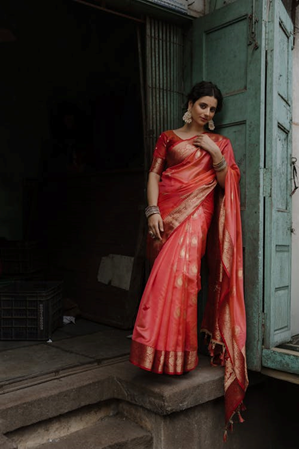 Usual/Basic Saree
Draping: This is one of the classic and known saree draping
processes that every woman is familiar with. This draping process starts with
the securing petticoat, tucking the plain ends of the saree, wrapping it around
the waist, creating pleats, tucking the pleats, and draping the pallu.
This is one of the known and renowned sarees draping styles that is followed by the majority
of the country and states.Many people like to
drape their saree as a basic style for weddings and any occasion and it
can be both a pleated pallu and open pallu. It all depends upon the
personality and comfort zone which reflects the art of saree draping.
Usual/Basic Saree
Draping: This is one of the classic and known saree draping
processes that every woman is familiar with. This draping process starts with
the securing petticoat, tucking the plain ends of the saree, wrapping it around
the waist, creating pleats, tucking the pleats, and draping the pallu.
This is one of the known and renowned sarees draping styles that is followed by the majority
of the country and states.Many people like to
drape their saree as a basic style for weddings and any occasion and it
can be both a pleated pallu and open pallu. It all depends upon the
personality and comfort zone which reflects the art of saree draping.
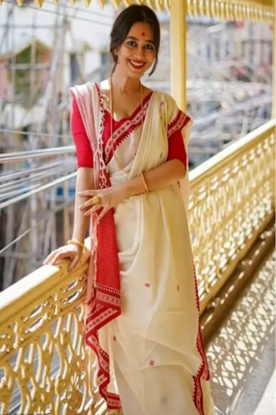
Bengali Atpoure Style: This is the most famous Bengali saree draping style, which is followed by different regions of Bengal. It is also the most renowned draping style, which is known as “Bengali saree Draping.” Jnanadanandini Devi Tagore, sister-in-law of Rabindranath Tagore and the wife of Satyendranath Tagore, is credited and introducing the Atpoure draping Idea, also known as Nivi drape, a new style of wearing a saree with a blouse and petticoat. Jnanadanandini Devi adapted the Atpoure drape or Nivi drape to conform to a new combination of Bengali and Parsi styles. She keeps the Bengali tradition on by providing an elegant touch of Parsi style by wearing a Parsi jacket and petticoat. The main idea is to put the pallu on the left shoulder and this was the main attractive draping idea that went for an ad in the women's magazine “Bambodhini Patrika” in the 19th Century.
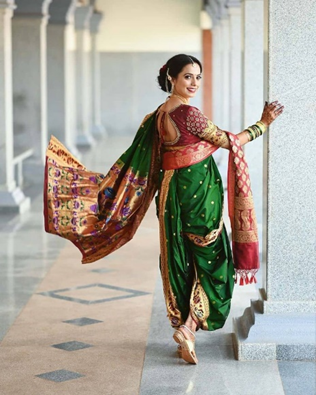 Dhoti Style Drape: The Koli tribes’ women are known for this style of draping which is
used by a nine-yard cotton saree partitioned by two parts. The women used
one part for the upper portion and another part for the lower portion.
This style is similar to the Marathi style of saree draping where women
are dressed in this dhoti style with attractive ornament like “Nathni”. The
Koli people are the indigenous group in Maharashtra, and it has been acknowledged
that the main origin of the Dhoti-style saree is Maharashtra. This Dhoti
style saree is also known as Nauvri saree as it is nine yards in length
and is worn without a petticoat. It has been estimated that in the Indus
Valley civilization, the men wore this type of drape in the bronze age.
Over time, the Dhoti style has gained popularity across India.
Dhoti Style Drape: The Koli tribes’ women are known for this style of draping which is
used by a nine-yard cotton saree partitioned by two parts. The women used
one part for the upper portion and another part for the lower portion.
This style is similar to the Marathi style of saree draping where women
are dressed in this dhoti style with attractive ornament like “Nathni”. The
Koli people are the indigenous group in Maharashtra, and it has been acknowledged
that the main origin of the Dhoti-style saree is Maharashtra. This Dhoti
style saree is also known as Nauvri saree as it is nine yards in length
and is worn without a petticoat. It has been estimated that in the Indus
Valley civilization, the men wore this type of drape in the bronze age.
Over time, the Dhoti style has gained popularity across India.
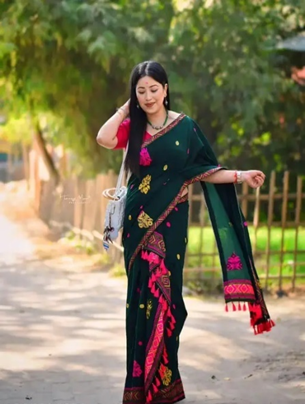 Assam Drape Saree: The Assam saree drape of Mekhla Sador is the traditional Assamese
dress that is originated from Riha, a cloth that used to drape the entire body including
the head but leaving the face exposed.Mekhla Chador/Sador which is assembled from
Assam carried its tradition from the Ahom rules in the 13th to
19th century. The women wear sarees in two parts the upper part is
known as Chador/Sador and the lower part is known as Mekhla. This Mekhla Sador
is made up of silk such as Muga, and Pat silk with attractive patterns
and motifs. This is famous attire for the Assamese in their wedding. The designs
in the Mekhla are inspired by nature, culture and mythological stories that enhance
the beauty of the saree and make the saree more attractive.
Assam Drape Saree: The Assam saree drape of Mekhla Sador is the traditional Assamese
dress that is originated from Riha, a cloth that used to drape the entire body including
the head but leaving the face exposed.Mekhla Chador/Sador which is assembled from
Assam carried its tradition from the Ahom rules in the 13th to
19th century. The women wear sarees in two parts the upper part is
known as Chador/Sador and the lower part is known as Mekhla. This Mekhla Sador
is made up of silk such as Muga, and Pat silk with attractive patterns
and motifs. This is famous attire for the Assamese in their wedding. The designs
in the Mekhla are inspired by nature, culture and mythological stories that enhance
the beauty of the saree and make the saree more attractive.
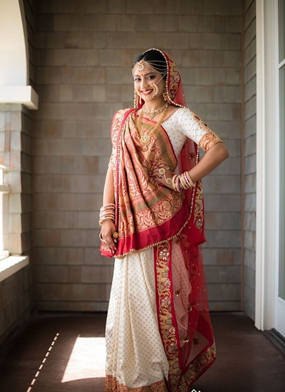 Front Pallu Style: This is one of the basic and modern saree draping ideas in India
acknowledged by the majority of women. The basic feature of the saree is
to leave the pallu in front of the breast. The majority of women follow this
style
Front Pallu Style: This is one of the basic and modern saree draping ideas in India
acknowledged by the majority of women. The basic feature of the saree is
to leave the pallu in front of the breast. The majority of women follow this
style to showcase the heavy design of the pallu which are the main eye-catching
things in the entire saree. Front pallu style originated from Gujrat which is
also known as the seedha pallu style. History says that it comes from
ancient India where the traces were found in ancient Egyptian and
Greek designers. This draping style feels comfortable to the women as the pallu
can be secure over the shoulder and the women can manage heavy tasks.
The draping style also depends upon the material of the saree, fabrics, designs and the personality of and individual. You can find different sarees with unique designs on Parthi that help to select the best draping ideas to enhance beauty.